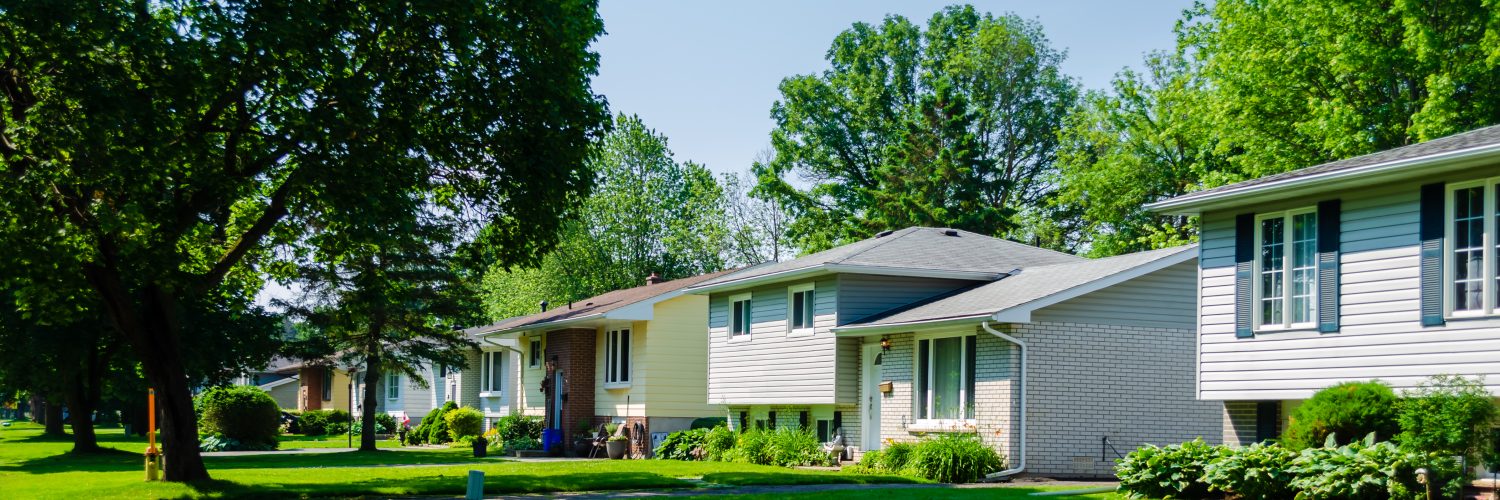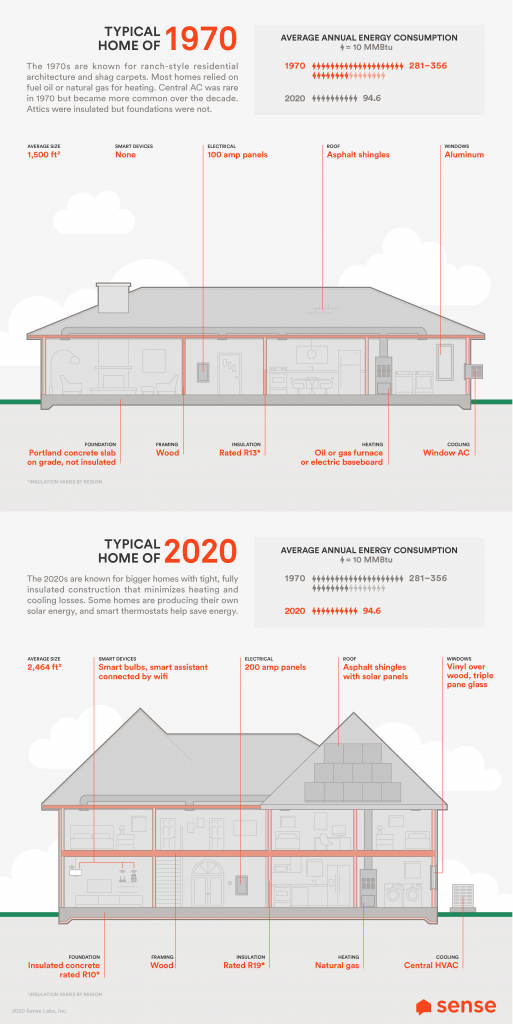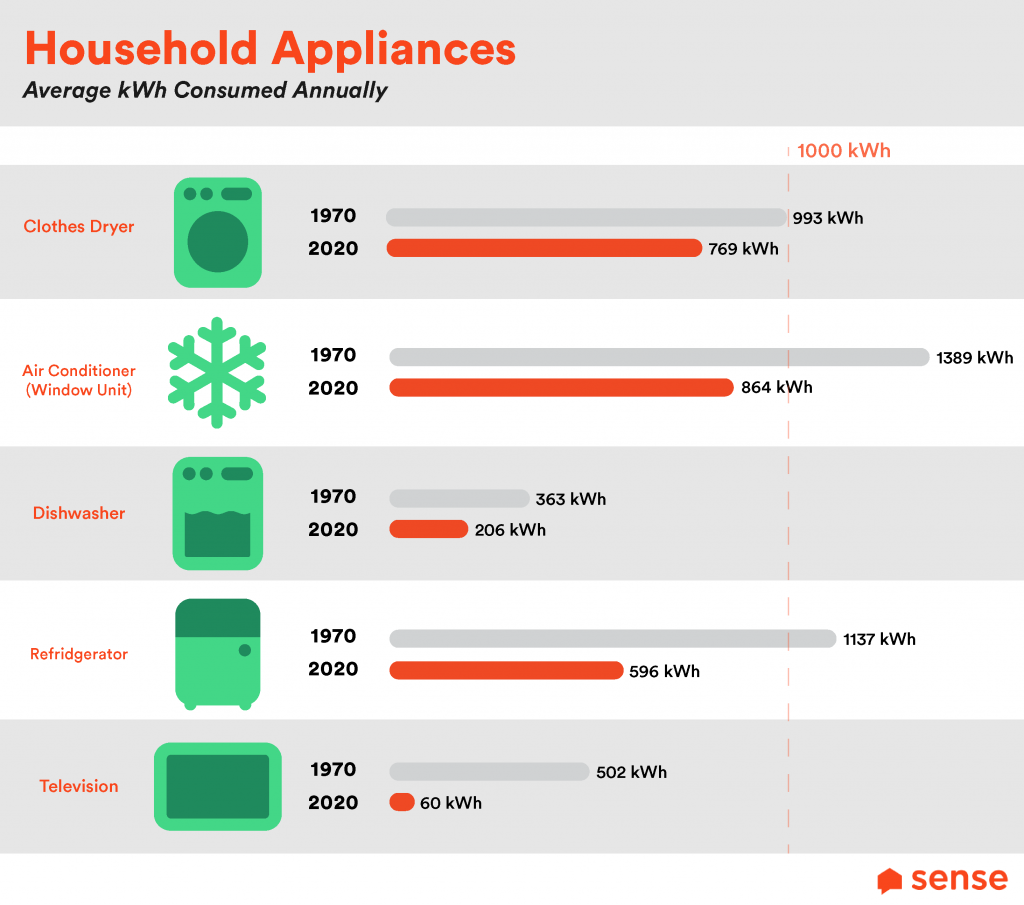On the 50th anniversary of Earth Day, here’s how to give your older house an energy overhaul.
This year marks the 50th anniversary of Earth Day. Since the first Earth Day in 1970, changes in building codes have made homes much more efficient, cutting energy use by 47% even though the typical new home has expanded by about 900 square feet. But housing is still responsible for about 20% of greenhouse gases in the U.S. To address climate change, all homes will need to become smarter and less wasteful, especially older homes.
The reality is that most people don’t live in new, efficient houses. In fact, more than half of all owner-occupied homes were built before 1980, with around 38% built before 1970. The typical home is about 37 years old which means that many of us live in houses that might have been around on that original Earth Day in 1970.
A number of changes have made today’s homes more efficient than homes built in 1970. Building insulation and materials have improved. The foundations, walls and attic in homes built today are tightly insulated. By comparison, a 1970 home would have light insulation in the walls and an insulated attic.
On a broader scale, homes became more efficient, on average, because more people moved from colder to warmer areas of the country, where total energy demand is lower. And with working parents, people are outside the home more and rely on take-out food rather than home cooking. Both of these trends reduce the typical home’s energy usage.
Heating and cooling equipment, water heaters, refrigerators, lighting, and appliances have all become much more efficient since 1970. Debuted in 1992 by the EPA, the ENERGY STAR certification has impacted the design and energy ratings of many household appliances.
So how can older homes catch up to the energy efficiencies of new homes? To get there, you’ll want to consider updates that make your older home more like a new one:
- Add solar panels to produce electricity and move your home closer to net zero. Sense Solar will track your solar production and energy usage in real time so you can optimize your solar investment.
- Space and water heating together account for 62% of the typical home’s energy use. Air source heat pumps have evolved to become a viable alternative in colder regions of the country. They can save 3,000 kWh (or $459) compared to electric resistance heaters, and 6,200 kWh (or $948) compared to oil systems. Those savings add up year over year.
- Use smart thermostats to automatically adjust heating and cooling, saving energy and cost.
- When your water heater gets old, consider a new heat-pump water heater to replace it. They are 2-3x more efficient than traditional water heaters. Don’t wait till the water heater is broken to make a hasty decision for a replacement.
- Hire a contractor to add a super-tight barrier between the inside and outside walls of the home. Make this change if you need to remove and update siding, or if you’re planning an addition.
- Take advantage of rebates from your utility to add insulation to your attic. Be sure that the installers carefully seal cracks in the attic floor before laying down the insulation.
- Consider insulating basement walls from the outside, if they are accessible.
- Install energy-efficient triple pane windows or low e-storm windows. Remember to weather-strip doors, also, and make sure the frames are well sealed.
- Update all your lighting to LEDs, which use about 1/7th the energy of an incandescent.
- Choose appliances with Energy Star ratings.
Some of these updates require a significant investment, but homes, like cars, require maintenance. Water heaters break unexpectedly, siding gets brittle, and old windows let too much cold air into your room. Somehow repairs seem to crop up when they are least welcome.
Most Americans are at home and many of us are worried about our financial futures. Now could be a good time to take a home inventory so you can anticipate needed repairs and make the best decisions thoughtfully.
Here’s a checklist to get you started.
- Look at your total annual electrical cost in the Sense app or your utility bill. Use a solar calculator to figure out how much you’d save with solar panels. How long will it take to pay off the panels? Will you be in your home that long? Would solar leasing work better for you?
- Check your water heater to see how old it is. Investigate alternatives so you’re ready with a replacement option when your current water heater is near the end of its life or suddenly breaks down.
- How old is your furnace? Do the math to figure out when a replacement makes sense and investigate your options. If you rely on heating oil, you could save right away by switching to a more efficient option.
- Electricity utility programs across the country are saving customers money through energy efficiency programs. Check out your local utility’s programs. Many utilities are conducting virtual energy audits nowadays. Take advantage of them to find out how you can reduce your bills. If you have Sense installed, share your data with the inspector to inform their recommendations.
- Walk around your house to inspect the siding and foundation. Will you need to replace siding within the next 10 years? Are you planning other home renovations that will provide an opportunity to insulate your walls to higher standards? Will you have an opportunity to insulate the foundation from the outside?
- Research federal, state and local incentives and rebates for a variety of home improvements, ranging from lighting to window replacements. Decide which ones will have the biggest impact on your utility costs and which you can afford when.
- Are your appliances more than 10 years old? Are they Energy Star rated? Consider the best replacements before they break down.
- Make a plan so you can schedule and budget projects as your home needs maintenance or you can make improvements.
As you consider renovations for your older house, you can find inspiration at This Old House. The Old House crew renovated architect Don Powers’ early 1900s Craftsman-style cottage in Rhode Island, transforming it into a net zero home.
While these updates will go a long way toward moving an older home into the modern era, how you live every day is just as important. At Sense we’ve heard from homeowners who’ve saved hundreds or even thousands of dollars by discovering hidden energy hogs in their homes. Take an energy inventory of all the gadgets and appliances in your home using the Sense app to find out which ones are using the most energy. The old refrigerator in your garage or the pool pump that runs all summer may be costing you more than you think. Keep taking small steps that will save you energy right away. Each savings adds up!
Sense can help you plan for the long term in another way. On average, a 1970 home used 161M BTUs of energy annually while a new house uses nearly 95M BTUs. How much electricity did your home use last year? You can check the Dashboard tab in the Sense app and look at your last full year of usage. Tap on the total dollar amount to switch to kilowatt hours and use an online calculator to arrive at your total BTUs.
If your home relies on electricity, you can compare your energy footprint to the 1970 and current homes. If your home relies on natural gas for heating, you’ll need to take a few more steps to calculate the total annual BTUs from your gas utility bill.
How do you compare to the averages? Seeing your own home’s total usage can help you understand the feedback you get in the “compared to neighbors” information from your utility or in the Sense app.
With a thoughtful plan for upcoming repairs and improvements, you can make your older home as efficient as a brand new 2020 home!




















